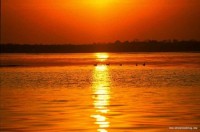By Agence France-Presse, Beijing
About 100,000 migratory birds disappeared in recent fierce snow storms in eastern China, state media reported Sunday.About 95 percent of the world’s white cranes, half of the white-naped cranes and 60 percent of swan geese are believed to migrate to a nature reserve at Poyang Lake each year in Jiangxi province, Xinhua news agency said.Poyang Lake is China’s biggest fresh water lake and an internationally significant wetland area.
Hundreds of workers at the reserve distributed grain, corn and vegetables but found only 40,000 birds, leaving about 100,000 unaccounted for, said Luo Shengjin, deputy director of the reserve. Luo said no mass deaths had been uncovered and the birds could have migrated elsewhere. But the reserve was still concerned and was planning to employ helicopters to widen the search for the missing birds.The worst weather in decades hit large areas of China last month, killing at least 107 people and causing more than 15 billion dollars in economic losses, according to official figures. Read more here.

Poyong Lake in Better Weather, a major wetland area for wildlife
CBC News‘
There’s an upside to the extreme cold temperatures northern Canadians have endured in the last few weeks: scientists say it’s been helping winter sea ice grow across the Arctic, where the ice shrank to record-low levels last year. Temperatures have stayed well in the -30s C and -40s C range since late January throughout the North, with the mercury dipping past -50 C in some areas. Satellite images are showing that the cold spell is helping the sea ice expand in coverage by about 2 million square kilometres, compared to the average winter coverage in the previous three years.
“It’s nice to know that the ice is recovering,” Josefino Comiso, a senior research scientist with the Cryospheric Sciences Branch of NASA’s Goddard Space Flight Centre in Maryland, told CBC News on Thursday. “That means that maybe the perennial ice would not go down as low as last year.” Canadian scientists are also noticing growing ice coverage in most areas of the Arctic, including the southern Davis Strait and the Beaufort Sea.
The cold is also making the ice thicker in some areas, compared to recorded thicknesses last year, Lagnis added. “The ice is about 10 to 20 centimetres thicker than last year, so that’s a significant increase,” he said. If temperatures remain cold this winter, Langis said winter sea ice coverage will continue to expand. See more here.
Telegraph UK
Drinking bottled water should be made as unfashionable as smoking, according to a government adviser. “We have to make people think that it’s unfashionable just as we have with smoking. We need a similar campaign to convince people that this is wrong,” said Tim Lang, the Government’s naural resources commissioner. Bottled water generates upto 600 times more CO2 than tap water
Phil Woolas, the environment minister, added that the amount of money spent on mineral water “borders on being morally unacceptable”. Their comments come as new research shows that drinking a bottle of water has the same impact on the environment as driving a car for a kilometre. Conservation groups and water providers have started a campaign against the 2 billion pound industry. A BBC Panorama documentary, “Bottled Water: Who Needs It?”, to be broadcast tomorrow says that in terms of production, a litre bottle of Evian or Volvic generates up to 600 times more CO2 than a litre of tap water. Read more here.


